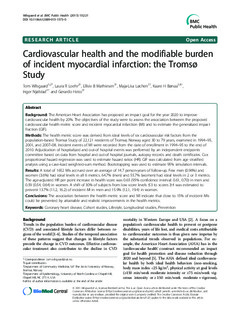| dc.contributor.author | Wilsgaard, Tom | |
| dc.contributor.author | Loehr, LR | |
| dc.contributor.author | Mathiesen, Ellisiv B. | |
| dc.contributor.author | Løchen, Maja-Lisa | |
| dc.contributor.author | Bønaa, Kaare Harald | |
| dc.contributor.author | Njølstad, Inger | |
| dc.contributor.author | Heiss, G | |
| dc.date.accessioned | 2016-03-01T10:16:16Z | |
| dc.date.accessioned | 2016-03-04T14:31:20Z | |
| dc.date.available | 2016-03-01T10:16:16Z | |
| dc.date.available | 2016-03-04T14:31:20Z | |
| dc.date.issued | 2015 | |
| dc.identifier.citation | BMC Public Health 2015, 15(1) | nb_NO |
| dc.identifier.issn | 1471-2458 | |
| dc.identifier.uri | http://hdl.handle.net/11250/2381502 | |
| dc.description.abstract | Background:The American Heart Association has proposed an impact goal for the year 2020 to improve
cardiovascular health by 20%. The objectives of the study were to assess the association between the proposed
cardiovascular health metric score and incident myocardial infarction (MI) and to estimate the generalized impact
fraction (GIF).
Methods:The health metric score was derived from ideal levels of six cardiovascular risk factors from the
population-based Tromsø Study of 22,121 residents of Tromsø, Norway aged 30 to 79 years, examined in 1994–95,
2001, and 2007–08. Incident events of MI were recorded from the date of enrollment in 1994–95 to the end of
2010. Adjudication of hospitalized and out-of hospital events was performed by an independent endpoints
committee based on data from hospital and out-of hospital journals, autopsy records and death certificates. Cox
proportional hazard regression was used to estimate hazard ratios (HR). GIF was calculated from age stratified
analysis using a case-load weighted-sum method. Bootstrapping was used to estimate 95% simulation intervals.
Results:A total of 1652 MIs accrued over an average of 14.7 person-years of follow-up. Few men (0.96%) and
women (3.6%) had ideal levels in all 6 metrics. 64.7% (men) and 55.7% (women) had ideal levels in 2 or 3 metrics.
The age-adjusted HR per point increase in health score was 0.65 (95% confidence interval: 0.61, 0.70) in men and
0.59 (0.54, 0.64) in women. A shift of 30% of subjects from low score levels≤3 to scores≥4 was estimated to
prevent 13.7% (11.2, 16.2) of incident MI in men and 15.9% (12.1, 19.4) in women.
Conclusions:The association between the health metric score and MI indicate that close to 15% of incident MIs
could be prevented by attainable and realistic improvements in the health metrics.
Keywords:Coronary heart disease, Cohort studies, Lifestyle, Longitudinal studies, Prevention | nb_NO |
| dc.language.iso | eng | nb_NO |
| dc.publisher | BioMed Central | nb_NO |
| dc.title | Cardiovascular health and the modifiable burden of incident myocardial infarction: The Tromsø Study | nb_NO |
| dc.type | Peer reviewed | nb_NO |
| dc.type | Journal article | en_GB |
| dc.date.updated | 2016-03-01T10:16:16Z | |
| dc.source.volume | 15 | nb_NO |
| dc.source.journal | BMC Public Health | nb_NO |
| dc.source.issue | 1 | nb_NO |
| dc.identifier.doi | 10.1186/s12889-015-1573-0 | |
| dc.identifier.cristin | 1277775 | |
| dc.description.localcode | © Wilsgaard et al.; licensee BioMed Central. 2015. This is an Open Access article distributed under the terms of the Creative Commons Attribution License (http://creativecommons.org/licenses/by/4.0), which permits unrestricted use, distribution, and reproduction in any medium, provided the original work is properly credited. The Creative Commons Public Domain Dedication waiver (http://creativecommons.org/publicdomain/zero/1.0/) applies to the data made available in this article, unless otherwise stated. | nb_NO |
